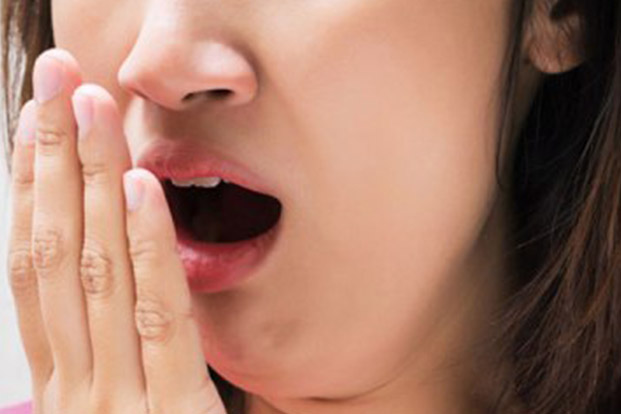Bad Breath – Causes, Management and Treatment
Apr 19, 2022
Halitosis, colloquially called bad breath is a symptom in which a noticeably unpleasant odor is present on the exhaled breath. Concern about halitosis is estimated to be the third most frequent reason for people to seek dental care, following tooth decay and gum disease; and about 20% of the general population are reported to suffer from it to some degree.
If you don’t brush and floss teeth daily, food Dr. meehha Goel particles can remain in your mouth, promoting bacterial growth between teeth, around the gums, and on the tounge. This causes bad breath.
Other dental causes of bad breath include poorly fitting dental appliances, yeast infections of the mouth, and dental caries (cavities).
The medical condition dry mouth (also called xerostomia) also can cause bad breath

What Can I Do to Prevent Bad Breath?
Bad breath can be reduced or prevented if you:
- Brush twice daily and especially clean your tongue. Change your brush in 3 months or after any illness.
- Use floss or an interdental cleaner to remove food particles between teeth once a day.
- Rinse with an antibacterial mouthwash twice a day.
- Dentures should be removed at night and cleaned thoroughly before being placed in your mouth the next morning.
- See your dentist regularly — at least twice a year. He or she will conduct an oral exam and professional teeth cleaning and will be able to detect and treat periodontal disease, dry mouth, or other problems that may be the cause of bad mouth odor.
- Drink lots of water. This will keep your mouth moist. Chewing gum (preferably sugarless) also stimulates the production of saliva, which helps wash away food particles and bacteria.
- Keep a log of the foods you eat. If you think they may be causing bad breath, bring the log to your dentist to review. Similarly, make a list of the medications you take. Some drugs may play a role in creating mouth odors.
Habits to Keep Teeth Healthy
Brushing, flossing, and rinsing are the basics of oral health, but they’re only the beginning. A marvelous mouth takes more than squeezing paste out of a tube — think improving your tooth brushing technique, and saying good-bye to cigarettes
Oral care musts for a healthy mouth-
· Recommended Related to Oral Health
- Coping With Dental Phobia
- Does the thought of succumbing to the dentist’s chair send a jolt of anxiety through your body? When it comes to triggering a fear response, few things can set people off like an upcoming trip to the dentist. That fear can set in early. Threatening comments from a parent, such as “If you don’t brush your teeth, you’ll have to go to the dentist,” can leave a lasting negative impression. More common, a painful experience at the dentist’s office during childhood triggers anxiety that carries over into…
- Read the Coping With Dental Phobia article > >
- See your dentist. If you’re prone to ditching the dentist, you’re among the roughly 50% of adults who don’t see a dentist yearly because of dental phobia, finances, or just plain neglect. But spend some quality time with your dentist (twice a year) and you’ll catch problems such as decay, gum disease, trauma, or cancer at an early stage when they’re treatable, not to mention more affordable to take care of.
- Dentist visit is a must. Children should see a dentist by the time they’re 1. Older adults can make brushing and flossing challenging, and as people age, the amount of saliva they produce decreases, which means more tooth decay and also discomfort for those who wear dentures.
- Reduce your soda intake. Fizzy is fun but also part of the reason soda is so bad for your teeth. Two ingredients — phosphoric acid and citric acid — give soda it’s “bite” but also eat away at the surface of your teeth. Switch to water instead, adding flavour with sliced citrus or crushed berries or mint leaves.
- Avoid much of Sugar. Sugar is a major culprit in tooth decay. It fuels bacteria and acidity in your mouth, causing plaque to form and eat away at your enamel and gums. Try to cut down on sugary treats, and aim to brush and floss after every meal or snack.
- Quit Smoking. You’ve heard it before. But this time, it’s your dentist talking. The nicotine and tar in cigarettes not only turn your teeth an unsightly shade of yellow, they eat away at your gums. Smoking creates a ripe environment for bacteria and plaque on your teeth and along the gum line that eventually, increases your risk of tooth loss. Even worse, tobacco chemicals can lead to oral cancer.
- Use the right toothbrush. You want a brush with soft bristles and narrow head for it to reach till your last tooth in the mouth. With the right technique, it should last two to three months.
- Practice proper technique. Although you probably know you should brush your teeth at least twice a day, if you’re like most people, you don’t give much thought to how to do it. Hold the toothbrush at a 45-degree angle, pointed toward the gum line, and use gentle, short, circular motions. Overly aggressive brushing can damage teeth and erode your gum line.


